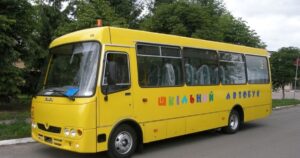
The municipal institution “Center for Financial and Statistical Monitoring, Material and Technical and Information Support of Educational Institutions” of the Mykolaiv Regional Council will purchase 40 Ataman school buses manufactured by the Cherkasy Bus plant by June 1 of this year for UAH 147.83 million, compared to the expected purchase price of UAH 148.36 million.
According to a report in Prozorro, the city council signed the relevant agreement with Isuzu-Ataman Ukraine JSC on December 31 following the results of a tender in which the company was the only participant.
In particular, 39 regular school buses will be purchased for UAH 143.91 million (including VAT), at a price of UAH 3.69 million per bus, and one bus with two seats for schoolchildren with limited mobility will be purchased for UAH 3.92 million.
Full payment is expected within 10 banking days.
Isuzu-Ataman Ukraine will supply buses manufactured in 2025 that meet Euro 5 environmental standards, with 28 seats for schoolchildren and three for accompanying persons and crew members. The degree of localization is 68.8%.
The specialized bus has 21 seats for schoolchildren, including two for children with limited mobility, as well as two seats for accompanying persons. The degree of localization is almost 71%.
According to YouControl, PJSC Isuzu-Ataman Ukraine, which, among other things, trades in Isuzu and Ataman vehicles, received UAH 49.2 million in net profit in January-September 2025, which is 56% more than in the same period in 2024, and its net income increased 2.4 times to UAH 408 million.
As reported, the state budget subsidy for the purchase of school buses next year is UAH 2 billion, compared to UAH 1.6 billion in 2025.
According to the Ministry of Economy, the Mykolaiv region purchased 25 buses last year. The subsidy from the state budget for the region amounted to UAH 23.54 million.
Since 2024, the School Bus program has been implemented thanks to financial cooperation between the EU and Ukraine within the framework of the Ukraine Facility instrument. In particular, school buses must have seats for students with limited mobility.
The required level of localization in 2026 is at least 30%.
According to preliminary data, 720 school buses were implemented in 2025 with state subsidies and co-financing from local communities.

In 2025, Moldova was heavily dependent on imports of milk and dairy products, with Ukraine supplying more than two-thirds of the product to the local market, according to the Moldovan publication rupor.md, citing data from the republic’s Customs Service.
According to Moldovan customs, in January–November 2025, Moldova imported 26.7 thousand tons of milk and dairy products worth a total of $23.4 million. The largest volume of raw milk as a raw material came from Ukraine — 16.8 thousand tons (66.1% of total imports). Romania, Poland, and Belarus are also among the leaders in milk raw material supplies.
According to customs data, Moldova also imported finished dairy products, including sour cream and milk mixtures.
In the segment of full-fat sour cream (over 10%), Ukraine’s share was even higher — over 80% of imports. In addition, Ukraine led in the supply of milk and sour cream with added sweeteners, accounting for almost 68% of imports.
Ukraine significantly outperformed its competitors from Romania, Poland, and Belarus in the supply of dairy products.
“Moldova’s dependence on milk imports from Ukraine is due to close trade ties between the countries and geographical proximity, which significantly reduces logistics costs for importers,” Moldovan experts explained.

In 2025, the state-owned enterprise Medical Procurement of Ukraine (MPU) purchased 866 items of medical goods for a total of UAH 15.7 billion from the budget, as well as 48 units of equipment for UAH 426 million from donors to the UNITED24 platform.
According to a press release from MZU, medical goods purchased with budget funds account for more than 97% of the quantities allocated by the Ministry of Health.
The amount of savings on purchases is UAH 1.7 billion.
In particular, the largest amount of state budget funds was spent on medicines and medical products for the treatment of cardiovascular diseases: 159 items were purchased for UAH 2.7 billion.
The Ministry of Health purchased 34 items of innovative medicines under managed access agreements (MAA) for UAH 2.4 billion.
The Ministry of Health purchased 220 items of drugs for the treatment of cancer for UAH 2.3 billion, 35 items for the treatment of hemophilia in adults and children for UAH 1.6 billion, and 130 items of medical products for blood donation for UAH 1.4 billion.
The MOH notes that 30 armored evacuation vehicles for military medics, four ambulances, and 11 X-ray machines were purchased for a total of UAH 426 million using funds from the UNITED24 fundraising platform.
In addition, the Ministry of Health reports that in 2025, through the Prozorro Market electronic catalog, the medical section of which is administered by the Ministry of Health, purchases were made by 2,874 hospitals that concluded more than 60,000 agreements worth more than UAH 21 billion, which is almost a third more than the amount of purchases using the e-catalog in 2024.

According to the Ministry of Tourism and Sports of Thailand, from January 1 to December 21, 2025, 31.756 million foreign tourists visited the country, which is 7.25% less than in the same period in 2024. The largest markets during this period were Malaysia (4.38 million), China (4.36 million), India (2.40 million), and Russia (1.80 million).
Based on the results of the whole of 2025, the agency estimates the inbound flow at almost 32.97 million tourists (-7.23% y/y) and the revenue from their spending at 1.536 trillion baht (-4.71%). The top 10 markets by number of arrivals included Malaysia (4,520,856), China (4,473,992), India (2,487,319), Russia (1,898,837), South Korea (1,555,227), Japan (1,091,227), the United Kingdom (1,083,162), the United States (1,081,929), Taiwan (987,633), and Singapore (967,341).
Ukraine did not make it into the top ten countries in terms of tourist flow to Thailand in 2025. This means that the flow from Ukraine was lower than that of the country in 10th place (Singapore – about 967,000 tourists).
In the resort real estate market, this usually leads to tougher competition for buyers and developers focusing on audiences from countries that generate the main tourist flow (primarily Malaysia, China, India, Russia, and other top 10 markets).

In December 2025, Tunisia imported 6.2 thousand tons of Ukrainian bran and feed flour (HS code 2302) worth $1.1 million, which is almost 26% of the total volume of supplies from Ukraine during this period in physical terms, according to the information and analytical agency “ APK-Inform ” reported.
“These are the first deliveries of this type of Ukrainian product to Tunisia since the beginning of both the marketing and calendar year. At the same time, in 2024, this country did not purchase the specified Ukrainian products,” analysts said.
According to their information, since the beginning of the 2025/26 marketing year (July 1 – December 23), Ukraine has supplied 168.6 thousand tons of bran and feed meal to foreign markets for a total of $26.8 million. The main buyers were Turkey (111.2 thousand tons), Syria (15.6 thousand tons), and Romania (9.7 thousand tons).
“In 2025/26 MY, flour production in Ukraine may reach 1.9 million tons (-8.4% compared to 2024/25 MY), which will result in wheat bran production of 530 thousand tons. At the current export rates, this will allow the export potential of this segment to reach 320-330 thousand tons, which is 8-11% less than in the previous marketing year,” APK-Inform noted.

The municipal enterprise (ME) Kyivpastrans plans to purchase 16 new low-floor city trolleybuses with a length of over 11.9 m by December 1, 2026, for an estimated amount of UAH 306.344 million, according to the website of the Kyiv City State Administration.
“The renewal of the rolling stock is necessary to improve transport safety, ensure the stable operation of public transport, and reduce travel intervals on routes,” the statement said.
The required total passenger capacity is about 100 people, including 34 seats. The interior must provide space for passengers with reduced mobility, wheelchairs, strollers, and ramps.
Trolleybuses must be equipped with heating and air conditioning systems, tinted windows, LED lighting, external and internal information displays, and a system that blocks movement when the doors are open.
In addition, the vehicles must be equipped with a loudspeaker system for announcing the route and stops, as well as space for installing GPS trackers for traffic control and equipment for automated fare payment.
As reported, in October 2025, Kyivpastrans canceled the purchase of 40 low-floor trolleybuses for an expected amount of more than UAH 1.008 billion due to the inability to make changes to the technical requirements of the tender documentation, which would lead to a change in the estimated purchase price.
Earlier, Kyiv canceled the purchase of 20 buses for almost UAH 83 million by the end of 2025, announced at the end of August 2025, for the same reason.
In addition, as part of a EUR 50 million loan agreement with the European Investment Bank, Kyiv announced in the summer of 2024 the purchase of 12-meter and 18-meter trolleybuses without specifying the number of each length, but the final outcome of this tender is still unknown.